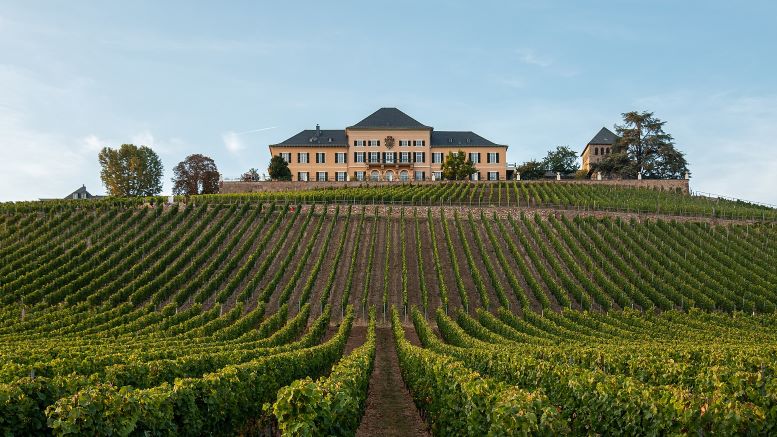Spotlight on the German White Wines along the Mosel & Rhine rivers (Part I)
Some of the world’s finest, longest-living white wines are made in the vineyards that line the steep hillsides along the Rhine and Mosel rivers in Germany. Let’s take a quick look into the history, geography and grape varieties that make Germany one of the most interesting wine countries to discover.
When talking about Old World wine regions Germany is not among the first that pop into mind. France, Italy, Spain, the usual suspects come first. Germany doesn’t make an appearance until all warm climate regions have been thought of and then it might come before or after Austria. However Germany has a long and noteworthy history in wine making, and in its beginnings, very similar to that of France.

Credit photo Canva
History
The Romans were the first to recognise that the steep slopes overlooking the river Mosel and its tributaries were the ideal terroir for planting vines. In a poem dating back to 370AD Roman poet Ausonius writes about the green hills planted with grapes of Bacchus and the lovely waters of the “Mosella” flowing silently beneath. During the Middle Ages, Cistercian and Benedictine monks were very influential in the development and production of quality wine in many German wine regions, much in the same way they were in Burgundy and the rest of France. However, it began to decline in the 17th century largely because of the ricing in popularity of beer especially in the north of the country.
The late 18th Century saw the development of high quality sweet, “late harvest” wines. These wines, called Spatlese wines were made from Riesling grapes affected by Botrytis (noble rot) and by the early 19th century were selling for prices above those of first-growth Bordeaux! The 20th century with its two World Wars and post war austerity saw another big decline in the production of quality German wines. Winemakers focused on producing large quantities of sweet, blended wines made from inferior quality grapes something that left a negative mark on their reputation.
In 1971 the Wine Classification System was introduced in an effort to better control the quality of the wines. It introduced a hierarchy known as the Pradikat scale which accessed the ripeness of the grapes based on their sugar levels at harvest. But it will take roughly another three decades for German winemakers to repair the damage they had done.
The last significant change to the German wine scene is the rise of the trocken (dry) wines. Almost two thirds of all German wine, not just white, is now made dry. These wines have nothing in common with the insipid, tart whites and reds of the 1980s. All thanks to Germany’s determined new generation of vine growers and climate change that has brought warmer summers and riper grapes.
Geography and Climate
At around 50 ̊ north latitude Germany possesses some of the most northern vineyards in the world. The climate is cool, with mild summers and cold winters. The River Rhine and its tributaries are the lifeblood of German viticulture. The flowing water reflects sunlight back onto the vineyards, warming the vines, helping them to ripen their grapes. Vineyards are perched on extremely steep, south facing slopes. Nothing else can grow there. If it wasn’t for the vines there would have been forest or just bare mountains.
Grape Varieties
No other wine producing region is as profoundly defined by a grape variety as Germany is by Riesling. German Rieslings have a worldwide reputation for quality, complexity and the ability to age for a long time. Nevertheless, there is a whole world of wines in Germany ranging from the familiar Pinot Noir, called Spatburgunder here, to the most unusual such a Scheurebe (white) and Dornfelder (red).
White Grapes

Schloss Johannisberg (Rheingau) Image: Martin Kraft (photo.martinkraft.com) License: CC BY-SA 4.0 via Wikimedia Commons
Müller-Thurgau, is the second most planted grape in the country and gives lightly floral and fresh wines perfect from everyday drinking. These wines pair beautifully with vegetable dishes like roasted asparagus and fresh salads. Pinot Gris and Pinot Blanc – called Grauburgunder and Weissburgunder respectively – can also be found throughout Germany. Some can be bold and aromatic with white peach and lemon zest and are great with roasted pork and some are lighter and refreshing and perfect with soft, somewhat “stinky” cheeses. Sylvaner gives crisp, juicy and food friendly light-bodied white wines that can be enjoyed as an aperitif or with fresh seafood and grilled fish. Scheurebe is primarily grown in the Rheinhessen and is a hybrid of Riesling and an unknown wild grape. It is an aromatic grape and gives wines with notes of black currant and grapefruit!
Red Grapes
Apart from its very popular white wines, Germany has been producing increasingly respectable reds. Spatburgunder – Pinot Noir – is the leading red grape. Germany is the third-largest producer of Pinot Noir in the world and gives us noteworthy spicy, refreshing and food friendly red wines. Try them with a roast pork tenderloin or even grilled salmon. Trollinger with its light body and strawberry flavours is perfect with cheese and charcuterie. Dormfelder is floral and tannic and is excellent with barbecues and sausages.
About the author:
 Maria Zioga was born in Greece but spent most of her life living abroad. She studied Political Science and Media and Communication at the London School of Economics and worked alongside the Greek Minister of Finance for 3 years. However, it was wine that captured her heart and became her passion. She is passionate about making wine accessible to everyone and loves teaching about it through fun yet informative seminars. She holds the WSET Level 3 certification and will be starting the WSET Diploma soon. In April 2019, she founded the Geneva Wine Society. She organises wine tastings and wine events in Geneva as well as online. Maria has lived and worked in various countries over the past 20 years.
Maria Zioga was born in Greece but spent most of her life living abroad. She studied Political Science and Media and Communication at the London School of Economics and worked alongside the Greek Minister of Finance for 3 years. However, it was wine that captured her heart and became her passion. She is passionate about making wine accessible to everyone and loves teaching about it through fun yet informative seminars. She holds the WSET Level 3 certification and will be starting the WSET Diploma soon. In April 2019, she founded the Geneva Wine Society. She organises wine tastings and wine events in Geneva as well as online. Maria has lived and worked in various countries over the past 20 years.
Facebook
Instagram: www.instagram.com/vinum_lore_ & www.instagram.com/genevawinesociety



 Maria Zioga was born in Greece but spent most of her life living abroad. She studied Political Science and Media and Communication at the London School of Economics and worked alongside the Greek Minister of Finance for 3 years. However, it was wine that captured her heart and became her passion. She is passionate about making wine accessible to everyone and loves teaching about it through fun yet informative seminars. She holds the WSET Level 3 certification and will be starting the WSET Diploma soon. In April 2019, she founded the Geneva Wine Society. She organises wine tastings and wine events in Geneva as well as online. Maria has lived and worked in various countries over the past 20 years.
Maria Zioga was born in Greece but spent most of her life living abroad. She studied Political Science and Media and Communication at the London School of Economics and worked alongside the Greek Minister of Finance for 3 years. However, it was wine that captured her heart and became her passion. She is passionate about making wine accessible to everyone and loves teaching about it through fun yet informative seminars. She holds the WSET Level 3 certification and will be starting the WSET Diploma soon. In April 2019, she founded the Geneva Wine Society. She organises wine tastings and wine events in Geneva as well as online. Maria has lived and worked in various countries over the past 20 years.